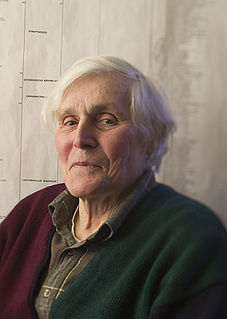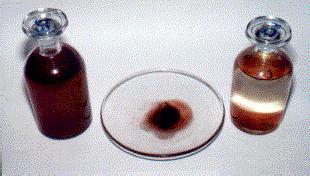
Astrobiology, formerly known as exobiology, is an interdisciplinary scientific field that studies the origins, early evolution, distribution, and future of life in the universe. Astrobiology considers the question of whether extraterrestrial life exists, and if it does, how humans can detect it.

Common descent is a concept in evolutionary biology applicable when one species is the ancestor of two or more species later in time. All living beings are in fact descendants of a unique ancestor commonly referred to as the last universal common ancestor (LUCA) of all life on Earth, according to modern evolutionary biology.

Evolution is change in the heritable characteristics of biological populations over successive generations. These characteristics are the expressions of genes that are passed on from parent to offspring during reproduction. Different characteristics tend to exist within any given population as a result of mutation, genetic recombination and other sources of genetic variation. Evolution occurs when evolutionary processes such as natural selection and genetic drift act on this variation, resulting in certain characteristics becoming more common or rare within a population. The circumstances that determine whether a characteristic should be common or rare within a population constantly change, resulting in the change in heritable characteristics arising over successive generations. It is this process of evolution that has given rise to biodiversity at every level of biological organisation, including the levels of species, individual organisms and molecules.

Extraterrestrial life, sometimes colloquially referred to as alien life, is hypothetical life that may occur outside Earth and which did not originate on Earth. Such life might range from simple prokaryotes to intelligent beings and even sapient beings, possibly bringing forth civilizations that might be far more advanced than humanity. The Drake equation speculates about the existence of sapient life elsewhere in the universe. The science of extraterrestrial life in all its forms is known as astrobiology.

Sir Fred Hoyle FRS (24 June 1915 – 20 August 2001) was an English astronomer who formulated the theory of stellar nucleosynthesis. He also held controversial stances on other scientific matters—in particular his rejection of the "Big Bang" theory, a term coined by him on BBC radio, and his promotion of panspermia as the origin of life on Earth. He also wrote science fiction novels, short stories and radio plays, and co-authored twelve books with his son, Geoffrey Hoyle. He spent most of his working life at the Institute of Astronomy at Cambridge and served as its director for six years. He was one of the authors of the influential B2FH paper.

Panspermia is the hypothesis that life exists throughout the Universe, distributed by space dust, meteoroids, asteroids, comets, and planetoids, as well as by spacecraft carrying unintended contamination by microorganisms. Panspermia is a fringe theory with little support amongst mainstream scientists. Critics argue that it does not answer the question of the origin of life but merely places it on another celestial body. It is also criticized because it cannot be tested experimentally.

The RNA world is a hypothetical stage in the evolutionary history of life on Earth, in which self-replicating RNA molecules proliferated before the evolution of DNA and proteins. The term also refers to the hypothesis that posits the existence of this stage.

Carl Richard Woese was an American microbiologist and biophysicist. Woese is famous for defining the Archaea in 1977 by phylogenetic taxonomy of 16S ribosomal RNA, a technique he pioneered that revolutionized microbiology. He also originated the RNA world hypothesis in 1967, although not by that name. Woese held the Stanley O. Ikenberry Chair and was professor of microbiology at the University of Illinois at Urbana–Champaign.

Horizontal gene transfer (HGT) or lateral gene transfer (LGT) is the movement of genetic material between unicellular and/or multicellular organisms other than by the ("vertical") transmission of DNA from parent to offspring (reproduction). HGT is an important factor in the evolution of many organisms.

The last universal common ancestor or last universal cellular ancestor (LUCA), also called the last universal ancestor (LUA), is the most recent population of organisms from which all organisms now living on Earth have a common descent—the most recent common ancestor of all current life on Earth. A related concept is that of progenote. LUCA is not thought to be the first life on Earth, but rather the latest that is ancestral to all current existing life.

Nalin Chandra Wickramasinghe is a Sri Lankan-born British mathematician, astronomer and astrobiologist of Sinhalese ethnicity. His research interests include the interstellar medium, infrared astronomy, light scattering theory, applications of solid-state physics to astronomy, the early Solar System, comets, astrochemistry, the origin of life and astrobiology. A student and collaborator of Fred Hoyle, the pair worked jointly for over 40 years as influential proponents of panspermia. In 1974 they proposed the hypothesis that some dust in interstellar space was largely organic, later proven to be correct.

The Kerala red rain phenomenon was a blood rain event that occurred in Wayanad district region of Malabar on Monday, 15 July 1957 and the colour subsequently turned yellow and also 25 July to 23 September 2001, when heavy downpours of red-coloured rain fell sporadically on the southern Indian state of Kerala, staining clothes pink. Yellow, green and black rain was also reported. Coloured rain was also reported in Kerala in 1896 and several times since, most recently in June 2012, and from 15 November 2012 to 27 December 2012 in eastern and north-central provinces of Sri Lanka.

The history of life on Earth traces the processes by which living and fossil organisms evolved, from the earliest emergence of life to present day. Earth formed about 4.5 billion years ago and evidence suggests that life emerged prior to 3.7 Ga. Although there is some evidence of life as early as 4.1 to 4.28 Ga, it remains controversial due to the possible non-biological formation of the purported fossils.

A prokaryote is a single-celled organism that lacks a nucleus, and other membrane-bound organelles. The word prokaryote comes from the Greek πρό and κάρυον. In the two-empire system arising from the work of Édouard Chatton, prokaryotes were classified within the empire Prokaryota. But in the three-domain system, based upon molecular analysis, prokaryotes are divided into two domains: Bacteria and Archaea. Organisms with nuclei are placed in a third domain, Eukaryota. In the study of the origins of life, prokaryotes are thought to have arisen before eukaryotes.

In biology, abiogenesis or the origin of life is the natural process by which life has arisen from non-living matter, such as simple organic compounds. While the details of this process are still unknown, the prevailing scientific hypothesis is that the transition from non-living to living entities was not a single event, but an evolutionary process of increasing complexity that involved molecular self-replication, self-assembly, autocatalysis, and the emergence of cell membranes. Although the occurrence of abiogenesis is uncontroversial among scientists, its possible mechanisms are poorly understood. There are several principles and hypotheses for how abiogenesis could have occurred.

In biology, an organism is any organic, living system that functions as an individual entity. All organisms are composed of cells. Organisms are classified by taxonomy into groups such as multicellular animals, plants, and fungi; or unicellular microorganisms such as protists, bacteria, and archaea. All types of organisms are capable of reproduction, growth and development, maintenance, and some degree of response to stimuli. Beetles, squids, tetrapods, mushrooms, and vascular plants are examples of multicellular organisms that differentiate specialized tissues and organs during development.

Evolution of cells refers to the evolutionary origin and subsequent evolutionary development of cells. Cells first emerged at least 3.8 billion years ago, approximately 750 million years after Earth was formed.
Directed panspermia is the deliberate transport of microorganisms into space to be used as introduced species on lifeless but habitable astronomical objects.

Diseases from Space is a book published in 1979 that was authored by astronomers Fred Hoyle and Chandra Wickramasinghe, where they propose that many of the most common diseases which afflict humanity, such as influenza, the common cold and whooping cough, have their origins in extraterrestrial sources. The two authors argue the case for outer space being the main source for these pathogens- or at least their causative agents.

The Tanpopo mission is an orbital astrobiology experiment investigating the potential interplanetary transfer of life, organic compounds, and possible terrestrial particles in the low Earth orbit. The purpose is to assess the panspermia hypothesis and the possibility of natural interplanetary transport of microbial life as well as prebiotic organic compounds.














